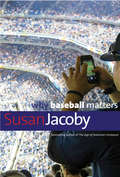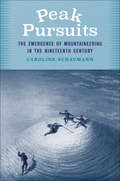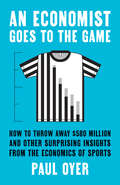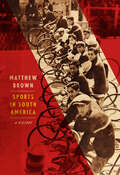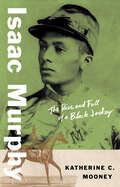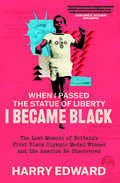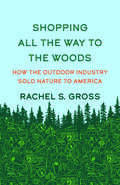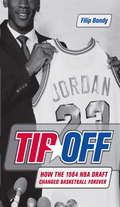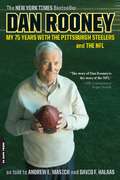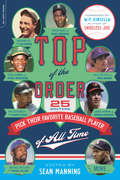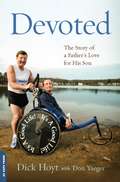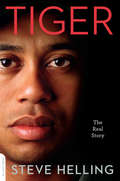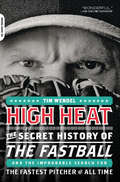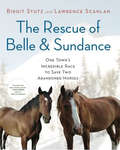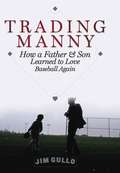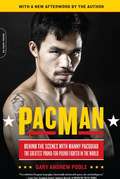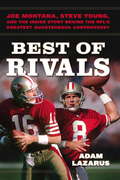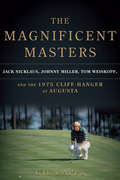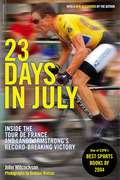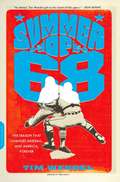- Table View
- List View
Why Baseball Matters (Why X Matters Series)
by Susan JacobyA best-selling author and passionate baseball fan takes a tough-minded look at America’s most traditional game in our twenty-first-century culture of digital distraction Baseball, first dubbed the “national pastime” in print in 1856, is the country’s most tradition-bound sport. Despite remaining popular and profitable into the twenty-first century, the game is losing young fans, among African Americans and women as well as white men. Furthermore, baseball’s greatest charm—a clockless suspension of time—is also its greatest liability in a culture of digital distraction. These paradoxes are explored by the historian and passionate baseball fan Susan Jacoby in a book that is both a love letter to the game and a tough-minded analysis of the current challenges to its special position—in reality and myth—in American culture. The concise but wide-ranging analysis moves from the Civil War—when many soldiers played ball in northern and southern prisoner-of-war camps—to interviews with top baseball officials and young men who prefer playing online “fantasy baseball” to attending real games. Revisiting her youthful days of watching televised baseball in her grandfather’s bar, the author links her love of the game with the informal education she received in everything from baseball’s history of racial segregation to pitch location. Jacoby argues forcefully that the major challenge to baseball today is a shortened attention span at odds with a long game in which great hitters fail two out of three times. Without sanitizing this basic problem, Why Baseball Matters remind us that the game has retained its grip on our hearts precisely because it has repeatedly demonstrated the ability to reinvent itself in times of immense social change.
Peak Pursuits: The Emergence of Mountaineering in the Nineteenth Century
by Caroline SchaumannAn interdisciplinary cultural history of exploration and mountaineering in the nineteenth century European forays to mountain summits began in the late eighteenth and early nineteenth centuries with the search for plants and minerals and the study of geology and glaciers. Yet scientists were soon captivated by the enterprise of climbing itself, enthralled with the views and the prospect of “conquering” alpine summits. Inspired by Romantic notions of nature, early mountaineers idealized their endeavors as sublime experiences, all the while deliberately measuring what they saw. As increased leisure time and advances in infrastructure and equipment opened up once formidable mountain regions to those seeking adventure and sport, new models of masculinity emerged that were fraught with tensions. This book examines how written and artistic depictions of nineteenth-century exploration and mountaineering in the Andes, the Alps, and the Sierra Nevada shaped cultural understandings of nature and wilderness in the Anthropocene.
An Economist Goes to the Game: How to Throw Away $580 Million and Other Surprising Insights from the Economics of Sports
by Paul OyerAn engaging look at the ways economic thinking can help us understand how sports work both on and off the field Are ticket scalpers good for teams? Should parents push their kids to excel at sports? Why do Koreans dominate women’s golf, while Kenyans and Ethiopians dominate marathon racing? Why would Michael Jordan, the greatest player in basketball, pass to Steve Kerr for the game-winning shot? Paul Oyer shows the many ways economics permeates the world of sports. His topics range from the business of sport to how great athletes use economic thinking to outsmart their opponents to why the world's greatest sports powerhouse (at least per capita) is not America or China but the principality of Liechtenstein. Economics explains why some sports cannot stop the use of performance-enhancing drugs while others can, why hundred-million-dollar player contracts are guaranteed in baseball but not in football, how one man was able to set the world of sports betting on its ear—and why it will probably never happen again. This book is an entertaining guide to how a bit of economics can make you a better athlete and a more informed fan.
Sports in South America: A History
by Matthew BrownThe first book to examine the transformation of sporting cultures in South America in the nineteenth and twentieth centuries Sports in South America follows the transformation of sporting cultures in South America leading up to Uruguay’s hosting of the first FIFA Men’s World Cup in 1930. Matthew Brown shows how South American soccer culture, envied worldwide, sprang out of societies that were already playing and watching games well before British sportsmen arrived to teach “the beautiful game.” These vibrant and distinct sporting traditions, including cycling, boxing, cockfighting, bullfighting, cricket, baseball, and horse racing, were marked by South American societies’ Indigenous and colonial pasts and by their leaders’ desire to participate in what they saw as a global movement toward human progress. Drawing on a wealth of original archival research, Brown debunks legends, highlights the stories of forgotten sportswomen and Indigenous sports, and unpacks the social and cultural connections within South America and with the rest of the world.
Isaac Murphy: The Rise and Fall of a Black Jockey (Black Lives)
by Katherine C. MooneyThe rise and fall of one of America’s first Black sports celebrities Isaac Murphy, born enslaved in 1861, still reigns as one of the greatest jockeys in American history. Black jockeys like Murphy were at the top of the most popular sport in America at the end of the nineteenth century. They were internationally famous, the first African American superstar athletes—and with wins in three Kentucky Derbies and countless other prestigious races, Murphy was the greatest of them all. At the same time, he lived through the seismic events of Emancipation and Reconstruction and formative conflicts over freedom and equality in the United States. And inevitably he was drawn into those conflicts, with devastating consequences. Katherine C. Mooney uncovers the history of Murphy’s troubled life, his death in 1896 at age thirty-five, and his afterlife. In recounting Murphy’s personal story, she also tells two of the great stories of change in nineteenth-century America: the debates over what a multiracial democracy might look like and the battles over who was to hold power in an economy that increasingly resembled the corporate, wealth-polarized world we know today.
When I Passed the Statue of Liberty I Became Black
by Harry Edward"Harry Edward was a hugely talented athlete and an extraordinary man who fought all his life for justice and fairness in the face of repeated prejudice. His story is as powerful today as it was when he lived it and I urge everyone to read this book"—Linford Christie, 1992 Olympic 100m Champion The lost memoir of Britain’s first Black Olympic medal winner—and the America he discovered After winning Olympic medals for Britain in 1920, Harry Edward (1898–1973) decided to try his luck in America. The country he found was full of thrilling opportunity and pervasive racism. Immensely capable and energetic, Harry rubbed shoulders with kings and presidents, was influential in the revival of Black theatre during the Harlem Renaissance, and became a passionate humanitarian and advocate for child welfare. He was present at some of the twentieth century’s most significant moments, worked alongside W. E. B. Du Bois and Orson Welles, and witnessed two world wars and the civil rights movement. Yet he was frustrated at almost every turn. Toward the end of his life he set down his story, crafting this memoir of athletics and activism, race and racism on both sides of the Atlantic. His manuscript went unpublished until now. This is the deeply engaging tale of Edward’s life—and a moving testament to his drive to form a better world.
Shopping All the Way to the Woods: How the Outdoor Industry Sold Nature to America
by Rachel S. GrossA fascinating history of the profitable paradox of the American outdoor experience: visiting nature first requires shopping No escape to nature is complete without a trip to an outdoor recreational store or a browse through online offerings. This is the irony of the American outdoor experience: visiting wild spaces supposedly untouched by capitalism first requires shopping. With consumers spending billions of dollars on clothing and equipment each year as they seek out nature, the American outdoor sector grew over the past 150 years from a small collection of outfitters to an industry contributing more than 2 percent of the nation’s economic output. Rachel S. Gross argues that this success was predicated not just on creating functional equipment but also on selling an authentic, anticommercial outdoor identity. In other words, shopping for the woods was also about being—or becoming—the right kind of person. Demonstrating that outdoor culture is commercial culture, Gross examines Americans’ journey toward outdoor expertise by tracing the development of the nascent outdoor goods industry, the influence of World War II on its growth, and the boom years of outdoor businesses.
Tip-Off: How the 1984 NBA Draft Changed Basketball Forever
by Filip BondyThe 1984 NBA draft is most remembered as the one where Michael Jordan slipped to third behind number-one pick Hakeem Olajuwon...and the immortal Sam Bowie. You could understand the Houston Rockets choosing Olajuwon, but how on earth could the Portland Trailblazers pass up Jordan for the injury-prone Bowie? For the first time, Filip Bondy pieces together the entire backstory of the draft: from Michael Jordan's indecision over whether he should declare himself eligible for the NBA draft after his junior year...to Charles Barkley's calculated attempt to avoid being drafted by the Philadelphia 76ers and to improve his position at the Olympic trials...to the trades that were considered but fatefully never made.
Tip-Off: How the 1984 NBA Draft Changed Basketball Forever
by Filip BondyThe 1984 NBA draft is most remembered as the one where Michael Jordan slipped to third behind number-one pick Hakeem Olajuwon...and the immortal Sam Bowie. You could understand the Houston Rockets choosing Olajuwon, but how on earth could the Portland Trailblazers pass up Jordan for the injury-prone Bowie? For the first time, Filip Bondy pieces together the entire backstory of the draft: from Michael Jordan's indecision over whether he should declare himself eligible for the NBA draft after his junior year...to Charles Barkley's calculated attempt to avoid being drafted by the Philadelphia 76ers and to improve his position at the Olympic trials...to the trades that were considered but fatefully never made.
Dan Rooney: My 75 Years with the Pittsburgh Steelers and the NFL
by Dan RooneyLegendary chairman of the five-time Super Bowl champion Pittsburgh Steelers, Dan Rooney, tells his life story for the first time. From growing up on Pittsburgh's notorious North Side, to vying with Johnny Unitas for top high school quarterback honors in Western Pennsylvania, from learning how to run a major sports franchise from his father, Art Rooney ("the Chief”), to helping shape the modern NFL, Rooney serves up a fascinating account of personal and professional achievement.He also discusses his relationships with players, coaches, NFL commissioners, his beloved family, and the devoted fans known as "Steelers Nation.”Whether advocating hiring more minority head coaches through creation of the Rooney Rule or helping pave the way for the merger of the AFL and NFL, Rooney reveals the dynamics that have made him such a respected force in pro football.
Top of the Order: 25 Writers Pick Their Favorite Baseball Player of All Time
by Sean ManningThere have been many anthologies devoted to our national pastime&’s greatest players, but here, at last, is one dedicated to those, for reasons far more personal than stats-based, we call our favorites. In Top of the Order twenty-five of today&’s premier sports journalists, cultural critics, novelists, and humorists (as well as a couple of former major leaguers) deliver memorable, never-before-published odes to their favorite players, past or present. By turns uplifting, woeful, and hilarious, these essays define what it means to be beset by that strange, incurable condition known as baseball fandom. Featuring original essays by: Roger Kahn on Jackie Robinson, Buzz Bissinger on Albert Pujols, Jonathan Eig on Lou Gehrig, Neal Pollack on Greg Maddux, Laura Lippman on Brooks Robinson, Jeff Pearlman on Garry Templeton, Jim Bouton on Steve Dembowski, Pat Jordan on Tom Seaver, Michael Ian Black on Mookie Wilson, Matt Taibbi on Jim Rice, Steve Almond on Rickey Henderson, and many more.
Devoted: The Story of a Father's Love for His Son
by Dick HoytThe remarkable story of a father's devotion to his wheelchair-bound son and how their bond inspired millions of people worldwide--"Dick and Rick prove that the seemingly impossible is possible with every step they take on their awe inspiring journey." (Uta Pippig, three-time winner of both the Boston and Berlin Marathons)Born a Spastic quadriplegic, Rick Hoyt was written off by numerous doctors who advised his parents, Dick and Judy, to put their son in an institution. But Dick and Judy refused.Fast-forward to seventh grade when Rick, who was attending Westfield Middle School, asked his dad to enter a charity race. But there was a twist: Rick wanted to run, too. Dick had never run a race before, but more challenging still, he would have to push his son's wheelchair at the same time. Dick and Rick were determined, however, to overcome any obstacle in their way.Now, over one thousand races later, including numerous marathons and triathlons, Dick Hoyt continues to push Rick's wheelchair. Affectionately known worldwide as Team Hoyt, they are as devoted to each other as ever, and continue to inspire millions with their trademark motto--"Yes, you can."
Devoted: The Story of a Father's Love for His Son
by Dick HoytThe remarkable story of a father's devotion to his wheelchair-bound son and how their bond inspired millions of people worldwide. Born a spastic quadraplegic, Rick Hoyt was written off by numerous doctors. They advised his parents, Dick and Judy, to put their firstborn son in an institution. But Rick's parents refused. Determined to give their son every opportunity that "normal" kids had, they made sure to include Rick in everything they did, especially with their other two sons, Rob and Russ. But home was one thing, the world at large, another. Repeatedly rebuffed by school administrators who resisted their attempts to enroll Rick in school, Rick's mother worked tirelessly to help pass a landmark bill, Chapter 766, the first special-education reform law in the country. As a result, Rick and other physically disabled kids were able to attend public school in Massachusetts. But how would Rick communicate when he couldn't talk? To overcome this daunting obstacle, Dick and Judy worked with Dr. William Crochetiere, then chairman of the engineering department at Tufts University, and several enterprising graduate students, including Rick Foulds, to create the Tufts Interactive Communication device (TCI). In the Hoyt household, it became known as the "Hope machine" as it enabled Rick to create sentences by pressing his head against a metal bar. For the first time ever, Rick was able to communicate. Then one day Rick asked his dad to enter a charity race, but there was a twist. Rick wanted to run too. Dick had never run a race before, but more challenging still, he would have to push his son's wheelchair at the same time. But once again, the Hoyts were determined to overcome whatever obstacle was put in their way. Now, over one thousand races later, including numerous marathons and triathlons, Dick Hoyt continues to push Rick's wheelchair. Affectionately known worldwide as Team Hoyt, they are as devoted as ever, continuing to inspire millions and embodying their trademark motto of "Yes, you can."
Tiger: The Real Story
by Steve HellingBorn to a father who described him as the "chosen one” and a mother who called him the "universal child,” Tiger Woods was groomed for the fame and influence that his parents believed was his destiny. At age twenty, he made his debut in a Nike commercial. "Hello, world,” he said. "Are you ready for me?” The world was ready. For the next thirteen years, Tiger nearly lived up to his parents' outsized expectations. He conquered the world of golf, settled down with a beautiful Swedish model, and started a family. His net worth approached one billion dollars. Everything was going according to plan-until the scandal hit. Steve Helling has long covered Tiger Woods's career, and here he draws on intimate sources- many speaking out for the first time-to create a never-before-seen portrait of the golfer.
Tiger: The Real Story
by Steve HellingBorn to a father who described him as the "chosen one” and a mother who called him the "universal child,” Tiger Woods was groomed for the fame and influence that his parents believed was his destiny. At age twenty, he made his debut in a Nike commercial. "Hello, world,” he said. "Are you ready for me?” The world was ready. For the next thirteen years, Tiger nearly lived up to his parents' outsized expectations. He conquered the world of golf, settled down with a beautiful Swedish model, and started a family. His net worth approached one billion dollars. Everything was going according to plan-until the scandal hit. Steve Helling has long covered Tiger Woods's career, and here he draws on intimate sources- many speaking out for the first time-to create a never-before-seen portrait of the golfer.
High Heat: The Secret History of the Fastball and the Improbable Search for the Fastest Pitcher of All Time
by Tim WendelWhat is it about a quality fastball that brings us to the edge of our seats? How is it humanly possible to throw faster than 100 mph? And the big question: Who is the fastest pitcher ever?High Heat takes us on what filmmaker Ken Burns calls a "compelling, relentless, riveting" quest to deliver answers to the most intriguing questions about the fastball. Wendel provides insight into one of baseball's most exhilarating yet mystifying draws while exploring the remarkable feats and trials of the pitchers who have attempted to master it.
The Rescue of Belle and Sundance: One Town's Incredible Race to Save Two Abandoned Horses (A Merloyd Lawrence Book)
by Lawrence Scanlan Birgit StutzIn December 2008, snowmobilers spot two abandoned horses high in the Canadian Rockies. Starving and frostbitten, the horses have trampled the ten-foot-deep snow into a narrow white prison. Those who reach them bring hay but also a gun, in case the horses are too far gone. A glint of life in the horses&’ eyes earns them the hay.The harrowing yet inspiring story of their near impossible rescue--involving the volunteer efforts of an entire village, first the excavation of a trench six feet deep and over 3280 feet long, and then a nearly 20 mile descent at negative 40 degrees--is sure to be read in one breathless sitting.
Trading Manny: How a Father and Son Learned to Love Baseball Again
by Jim GulloThe moving story of how a father and his young son recaptured their love of baseball—a winning testament to why the game matters and how it can still bring us together in spite of itselfIn recent years something hasn&’t been quite right with baseball. Ask Jim Gullo: he&’ll tell you even a seven-year-old kid knows it. In December 2007, just as Jim&’s young son Joe was beginning to develop a true passion for the game, the bombshell news of players&’ steroid use made it clear that America&’s pastime wasn&’t what it claimed to be. Suddenly, Jim found himself struggling to answer questions from Joe that had nothing to do with batting averages or World Series champions: &“What aresteroids? Who was using them? Wasn&’t it cheating? Why weren&’t the players who got caught suspended or punished by baseball?&”While Jim searched for the right words and Major League Baseball dithered, Joe took matters into his own hands: he removed the players who had been named as likely drug users from his prized baseball card collection and created a cheaters pile. Then he created a different category of suspected &“juicers&” to keep an eye on. He took these players&’ posters—even the poster of his favorite slugger, Manny Ramirez—down from his bedroom walls. The steroid scandal had clearly hit home.Rather than wait for an official explanation and apology from Major League Baseball that would never materialize, Jim and Joe set out to find their own answers. They traveled the country from coast to coast, from Spring Training contests to major and minor league games—speaking with players, prospects, and managers while tracking down the legends and ghosts of baseball&’s golden age. And one day they discovered an aging but dedicated prospect who would become not only a true role model for Joe, but also the unlikely inspiration to lure both father and son back to the game they loved.By turns humorous, heartbreaking, and inspiring, Trading Manny tells the story of their journey back to baseball—how along the way Joe traded his idol Manny for a more worthy hero, and Jim discovered something invaluable about being a father.
PacMan: Behind the Scenes with Manny Pacquiao--the Greatest Pound-for-Pound Fighter in the World
by Gary Andrew PoolePacMan is "a one-of-a-kind ride into the one-of-a-kind life of Manny Pacquiao."--Robert Cassidy, Newsday With his shellacking of Antonio Margarito in November 2010, Manny "PacMan" Pacquiao became the only boxer ever to win eight world championships in eight different weight classes. Proclaimed the "fighter of the decade" by ESPN and elected Congressman in the Philippines, he is an inspiration to his countrymen. But to many, he remains an enigma. In PacMan--named one of the best sports books of 2010 by the Guardian--Gary Andrew Poole pulls back the curtain in an "amazing tale of how a reed-thin Filipino, who left his home in the poorest pocket of the Philippines ("The City of Dust") at the age of 15 . . . became one of the most recognizable names and faces in the world" (Dallas Morning News). "Excellent."--Sports Illustrated
Best of Rivals: Joe Montana, Steve Young, and the Inside Story behind the NFL's Greatest Quarterback Controversy
by Adam LazarusIn this revealing, in-depth look at the NFL's greatest quarterback controversy, Adam Lazarus takes readers into the locker room and inside the huddle to deliver the real story behind the rivalry-when Joe Montana and Steve Young battled on and off the field and forged one of the finest football dynasties of all time. From 1987 to 1994, the two future Hall of Famers spurred each other on to remarkable heights, including three Super Bowl wins and four MVP awards, and set new standards for quarterback excellence.The two men couldn't have been more different in background, personality, and playing style, and their competition created as much tension as it did greatness, forcing Montana to prove that he was still the game's best quarterback and Young to prove that he was a worthy successor.Featuring candid interviews with Montana, Young, Jerry Rice, George Seifert, and many more, Best of Rivals brings to life the story of two sports legends, the golden era of football their rivalry presided over, and the amazing legacy it produced.
Best of Rivals: Joe Montana, Steve Young, and the Inside Story behind the NFL's Greatest Quarterback Controversy
by Adam LazarusIn this revealing, in-depth look at the NFL's greatest quarterback controversy, Adam Lazarus takes readers into the locker room and inside the huddle to deliver the real story behind the rivalry-when Joe Montana and Steve Young battled on and off the field and forged one of the finest football dynasties of all time. From 1987 to 1994, the two future Hall of Famers spurred each other on to remarkable heights, including three Super Bowl wins and four MVP awards, and set new standards for quarterback excellence.The two men couldn't have been more different in background, personality, and playing style, and their competition created as much tension as it did greatness, forcing Montana to prove that he was still the game's best quarterback and Young to prove that he was a worthy successor.Featuring candid interviews with Montana, Young, Jerry Rice, George Seifert, and many more, Best of Rivals brings to life the story of two sports legends, the golden era of football their rivalry presided over, and the amazing legacy it produced.
The Magnificent Masters: Jack Nicklaus, Johnny Miller, Tom Weiskopf, and the 1975 Cliffhanger at Augusta
by Gil CappsLong before any of the players actually hit a golf ball, the 1975 Masters Tournament was destined for the record books when Lee Elder became the first African-American ever invited to the exclusive Augusta club's tourney. He was among the veritable Hall of Fame-list of competitors that week: Arnold Palmer, Tom Watson, Gary Player, Lee Trevino, Hale Irwin, Billy Casper, and Sam Snead. But Elder, rattled by the media attention, missed the cut. By the weekend, this would be overshadowed, however, by a showdown of the game's three heavyweights: Jack Nicklaus, Johnny Miller, and Tom Weiskopf. Their back-and-forth battle would rivet the golfing world and dramatically culminate in one of the greatest finishes in Masters' history.Gil Capps, a twenty-two-year veteran of the golf industry with NBC Sports and the Golf Channel, recaptures, hole-by-hole, the thrilling drama of this singular event from golf's golden era, from the media-crazed build-up to the tournament's final dramatic putt that would change the game of golf forever.
The Magnificent Masters: Jack Nicklaus, Johnny Miller, Tom Weiskopf, and the 1975 Cliffhanger at Augusta
by Gil CappsThe 1975 Masters Tournament always seemed destined for the record books. A veritable Hall of Fame list of competitors had gathered that spring in Augusta, Georgia, for the game's most famous event, including Arnold Palmer, Tom Watson, Gary Player, Lee Trevino, Hale Irwin, Billy Casper, and Sam Snead. The lead-up had been dominated by Lee Elder, the first black golfer ever invited to the exclusive club's tourney. But by the weekend, the tournament turned into a showdown between the three heavyweights of the time: Jack Nicklaus, Johnny Miller, and Tom Weiskopf. Never before had golf's top three players of the moment summoned the best golf of their lives in the same major championship. Their back-and-forth battle would rivet the sporting world and dramatically culminate in one of the greatest finishes in golf history. In The Magnificent Masters, Gil Capps, a twenty-two-year veteran of the golf industry with NBC Sports and Golf Channel, recaptures hole-by-hole the thrilling drama of this singular event during golf's golden era, from the media-crazed build-up and intertwined careers of the three combatants to the tournament's final dramatic putts that would change the game of golf forever.
23 Days in July: Inside the Tour de France and Lance Armstrong's Record-Breaking Victory
by John WilcocksonTaking place over twenty-three days in July and across more than 2,100 miles of smooth blacktop, rough cobblestones, and punishing mountain terrain, the Tour de France is the most grueling sports event in the world. And in 2004, five-time champion Lance Armstrong set out to achieve what no other cyclist in the 100-year history of the race had ever done: win a sixth Tour de France.Armstrong had four serious challengers who wanted nothing more than to deny the man the French call Le Boss from achieving his goal. The major threat among them was the only other former Tour de France champion in last year's race, Germany's Jan Ullrich- The Kaiser. But when the race was over, Lance Armstrong once again wore the yellow jersey of victory.
Summer of '68: The Season That Changed Baseball--and America--Forever
by Tim WendelThe extraordinary story of the 1968 baseball season—when the game was played to perfection even as the country was being pulled apart at the seamsFrom the beginning, '68 was a season rocked by national tragedy and sweeping change. Opening Day was postponed and later played in the shadow of Martin Luther King, Jr.'s funeral. That summer, as the pennant races were heating up, the assassination of Robert Kennedy was later followed by rioting at the Democratic National Convention in Chicago. But even as tensions boiled over and violence spilled into the streets, something remarkable was happening in major league ballparks across the country. Pitchers were dominating like never before, and with records falling and shut-outs mounting, many began hailing '68 as “The Year of the Pitcher.”In Summer of '68, Tim Wendel takes us on a wild ride through a season that saw such legends as Bob Gibson, Denny McLain, Don Drysdale, and Luis Tiant set new standards for excellence on the mound, each chasing perfection against the backdrop of one of the most divisive and turbulent years in American history. For some players, baseball would become an insular retreat from the turmoil encircling them that season, but for a select few, including Gibson and the defending champion St. Louis Cardinals, the conflicts of '68 would spur their performances to incredible heights and set the stage for their own run at history.Meanwhile in Detroit—which had burned just the summer before during one of the worst riots in American history—'68 instead found the city rallying together behind a colorful Tigers team led by McLain, Mickey Lolich, Willie Horton, and Al Kaline. The Tigers would finish atop the American League, setting themselves on a highly anticipated collision course with Gibson's Cardinals. And with both teams' seasons culminating in a thrilling World Series for the ages—one team playing to establish a dynasty, the other fighting to help pull a city from the ashes—what ultimately lay at stake was something even larger: baseball's place in a rapidly changing America that would never be the same.In vivid, novelistic detail, Summer of '68 tells the story of this unforgettable season—the last before rule changes and expansion would alter baseball forever—when the country was captivated by the national pastime at the moment it needed the game most.
